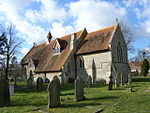Flint House, Buckinghamshire

Flint House is a domestic dwelling on the Waddesdon Estate, Buckinghamshire, England. It was commissioned by Jacob Rothschild, 4th Baron Rothschild, and completed in 2015, winning that year's RIBA House of the Year Award. The architect was Charlotte Skene Catling, a partner of Skene Catling de la Peña. The stones for the exterior were hand-knapped by master flint knappers John Lord and Simon Williams in Norfolk. The interiors were decorated and furnished by David Mlinaric, using an eclectic mix of modern contemporary pieces and older items from the Rothschild collection. The ethos of the house is that it blends and harmonises with the surrounding landscape and environment. The site chosen for the house, is an isolated spot at the heart of the Waddesdon estate in open countryside surrounded by grass pastures and arable fields. It can be accessed only by a narrow unmetalled track. While it is only a few hundred metres from its nearest neighbours, the new Rothschild Archive building and a farm cottage, a fold in the landscape prevents the sight of buildings from the house and enhances its senses of isolation and being in nature. Its architect has described the house as "jutting from the ground like a collision of tectonic plates".The house was given to the Rothschild Foundation, and is used to accommodate visitors including academics and artists working on projects at Waddesdon Manor, and the Rothschild Getty Fellow when at Waddesdon. It can be visited by arrangement at certain times.
Excerpt from the Wikipedia article Flint House, Buckinghamshire (License: CC BY-SA 3.0, Authors, Images).Flint House, Buckinghamshire
Geographical coordinates (GPS) Address Nearby Places Show on map
Geographical coordinates (GPS)
| Latitude | Longitude |
|---|---|
| N 51.8296 ° | E -0.9433 ° |
Address
Commonley's Farm
HP18 0JZ
England, United Kingdom
Open on Google Maps








